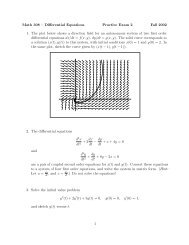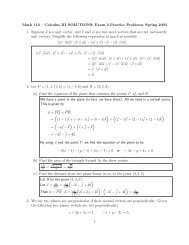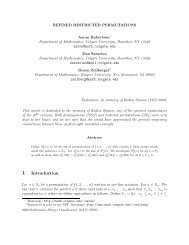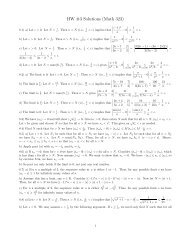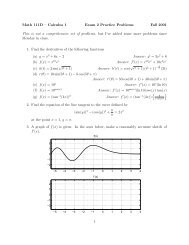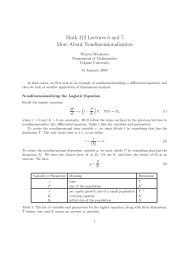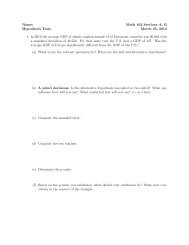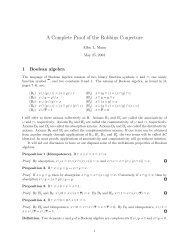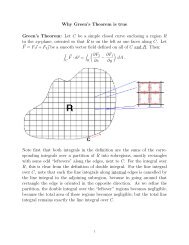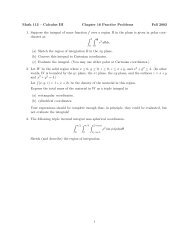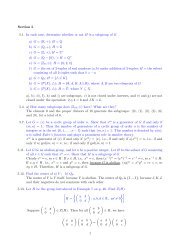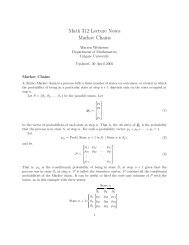Chapter 7: The Riemann Integral When the derivative is introduced ...
Chapter 7: The Riemann Integral When the derivative is introduced ...
Chapter 7: The Riemann Integral When the derivative is introduced ...
You also want an ePaper? Increase the reach of your titles
YUMPU automatically turns print PDFs into web optimized ePapers that Google loves.
<strong>Chapter</strong> 7: <strong>The</strong> <strong>Riemann</strong> <strong>Integral</strong><br />
<strong>When</strong> <strong>the</strong> <strong>derivative</strong> <strong>is</strong> <strong>introduced</strong>, it <strong>is</strong> not hard to see that <strong>the</strong> limit of <strong>the</strong> difference quotient<br />
should be equal to <strong>the</strong> slope of <strong>the</strong> tangent line, or when <strong>the</strong> horizontal ax<strong>is</strong> <strong>is</strong> time and <strong>the</strong> vertical<br />
<strong>is</strong> d<strong>is</strong>tance, equal to <strong>the</strong> instantaneous velocity. But <strong>the</strong> integral <strong>is</strong> not so easily interpreted: Why<br />
<strong>is</strong> <strong>the</strong> area under <strong>the</strong> curve in any way related to <strong>the</strong> anti<strong>derivative</strong> It really was a stroke of genius<br />
by Newton and Leibnitz to see that connection.<br />
In fact, integration, in <strong>the</strong> sense of area or volume, was invented first, many centuries earlier:<br />
Archimedes was involved in trying to compute <strong>the</strong> volume of a wine cask. <strong>The</strong> <strong>derivative</strong> was a<br />
much harder concept. In fact, Zeno’s paradoxes show how hard <strong>the</strong> Greeks found <strong>the</strong> concept of<br />
limit in general. Differentiation could really only be recognized and investigated after Descartes<br />
invented coordinate geometry. As a result, a few calculus texts, seeking a “h<strong>is</strong>torical” approach to<br />
<strong>the</strong> subject, cover integration before differentiation.<br />
Definition. Let f be a bounded function on a compact interval [a, b]. (We’ll see later why <strong>the</strong><br />
underlined words are important. For now, just note that we are not assuming that f <strong>is</strong> even<br />
continuous.)<br />
(a) A partition P of [a, b] <strong>is</strong> a finite subset of [a, b] containing a and b. If Q <strong>is</strong> ano<strong>the</strong>r partition<br />
and P ⊆ Q, <strong>the</strong>n Q <strong>is</strong> a refinement of P .<br />
(b) Write P = {x 0 , x 1 , x 2 , . . . , x n } where a = x 0 < x 1 < x 2 < · · · < x n = b. <strong>The</strong>n<br />
U(f, P ) =<br />
L(f, P ) =<br />
n∑<br />
sup{f(x) : x i−1 ≤ x ≤ x i }(x i − x i−1 )<br />
i=1<br />
n∑<br />
inf{f(x) : x i−1 ≤ x ≤ x i }(x i − x i−1 )<br />
i=1<br />
are <strong>the</strong> upper and lower sums with respect to f and P .<br />
(c) <strong>The</strong> upper and lower integrals of f on [a, b] are U(f) = inf{U(f, P )} and L(f) = sup{L(f, P )},<br />
where <strong>the</strong> inf and sup are taken over all partitions P of [a, b].<br />
(d) If U(f) = L(f), <strong>the</strong>n f <strong>is</strong> integrable on [a, b], and <strong>the</strong>ir common value <strong>is</strong> denoted ∫ b<br />
a f or<br />
f(x) dx.<br />
∫ b<br />
a<br />
Example. On <strong>the</strong> interval [a, b] with partition P as shown, consider <strong>the</strong> function f. We have<br />
U(f, P ) = N(x 1 − x 0 ) + M(x 2 − x 1 ) + N(x 3 − x 2 ) + M(x 4 − x 3 ) + M(x 5 − x 4 )<br />
L(f, P ) = 0(x 1 − x 0 ) + N(x 2 − x 1 ) + 0(x 3 − x 2 ) + N(x 4 − x 3 ) + 0(x 5 − x 4 )<br />
<strong>The</strong> blue region shows <strong>the</strong> area representing <strong>the</strong> upper sum, and <strong>the</strong> pink region <strong>the</strong> lower sum.
With a partition Q that refines P , <strong>the</strong> upper sum decreases and <strong>the</strong> lower sum increases:<br />
Replacing <strong>the</strong> partitions with ever finer ones, we see that <strong>the</strong> upper sums and lower sums approach<br />
each o<strong>the</strong>r, with <strong>the</strong> area of <strong>the</strong> three triangles as <strong>the</strong> common limit: U(f) = L(f) = ∫ b<br />
a f.
We see now why we restricted to bounded functions: So that <strong>the</strong> sup and inf of f on each<br />
subinterval ex<strong>is</strong>ts (and <strong>is</strong> finite). And similarly we restricted to bounded intervals so that we do<br />
not have infinitely long subintervals or infinitely many subintervals, making <strong>the</strong> upper and lower<br />
sums much harder or impossible to interpret. (We restricted to closed intervals so that <strong>the</strong> function<br />
has values at <strong>the</strong> endpoints.) Later in a calculus course integrals of unbounded functions or over<br />
unbounded or unclosed intervals might be allowed, but such things are always called “improper<br />
integrals” and interpreted as limits of proper integrals, limits that may or may not ex<strong>is</strong>t:<br />
Example. Improper integrals:<br />
∫ 1<br />
0<br />
∫ ∞<br />
1<br />
∫ ∞<br />
−∞<br />
1<br />
√ x<br />
dx = lim<br />
1<br />
√ x<br />
dx =<br />
ε→0 + ∫ 1<br />
lim<br />
M→∞<br />
sin x dx = lim<br />
M→∞<br />
ε<br />
∫ M<br />
1<br />
√ x<br />
dx = lim<br />
1<br />
∫ M<br />
<strong>The</strong> correct version of <strong>the</strong> last one <strong>is</strong><br />
−M<br />
1<br />
√ x<br />
dx =<br />
sin x dx =<br />
[<br />
2x 1/2] 1<br />
ε→0 +<br />
lim<br />
M→∞<br />
[2x 1/2] M<br />
= lim 2(1 − √ ε) = 2<br />
ε ε→0 +<br />
1 = lim<br />
M→∞ 2(√ M − 1) = ∞<br />
lim [− cos<br />
M→∞ x]M −M = lim 0 = 0<br />
M→∞<br />
∫ ∞<br />
−∞<br />
sin x dx =<br />
lim<br />
lim<br />
N→−∞ M→∞<br />
∫ M<br />
N<br />
sin x dx =<br />
lim<br />
N→−∞<br />
lim [− cos M→∞ x]M N<br />
does not ex<strong>is</strong>t<br />
<strong>The</strong> limit where <strong>the</strong> left and right endpoint approach −∞ and ∞ at <strong>the</strong> same rate <strong>is</strong> <strong>the</strong> called <strong>the</strong><br />
“principal value of <strong>the</strong> improper integral.”<br />
Example. A function that <strong>is</strong> not integrable: <strong>The</strong> Dirichlet function χ Q on [0, 1]. Every subinterval<br />
in every partition contains rational numbers, so <strong>the</strong> supremum of <strong>the</strong> χ Q -values on <strong>the</strong> subinterval<br />
<strong>is</strong> 1, so <strong>the</strong> upper sum for every partition <strong>is</strong> 1, so <strong>the</strong> upper integral <strong>is</strong> 1. But every subinterval in<br />
every partition also contains irrational numbers, so <strong>the</strong> infimum of <strong>the</strong> χ Q -values on <strong>the</strong> subinterval<br />
<strong>is</strong> 0, so <strong>the</strong> lower sum for every partition <strong>is</strong> 0, so <strong>the</strong> lower integral <strong>is</strong> 0.<br />
Lemma. For any bounded function f on <strong>the</strong> compact interval [a, b]:<br />
(a) For any partition P of [a, b], L(f, P ) ≤ U(f, P ).<br />
(b) For any partitions P, Q of [a, b], if P ⊆ Q, <strong>the</strong>n L(f, P ) ≤ L(f, Q) and U(f, P ) ≥ U(f, Q).<br />
(c) For any partition P of [a, b], L(f, P ) ≤ U(f) <strong>The</strong>refore, L(f) ≤ U(f).<br />
Proof. (a) On any subinterval [x i−1 , x i ], inf{f(x) : x i−1 ≤ x ≤ x i } ≤ sup{f(x) : x i−1 ≤ x ≤ x i }.<br />
(b) It <strong>is</strong> enough to assume that Q has only one more element than P , say P = {x 0 , x 1 , . . . , x n }<br />
and Q has <strong>the</strong> additional div<strong>is</strong>ion point x ∗ between x j−1 and x j . <strong>The</strong>n p = inf{f(x) : x j−1 ≤ x ≤
x j } <strong>is</strong> less than or equal to each of q 1 = inf{f(x) : x j−1 ≤ x ≤ x ∗ } and q 2 = inf{f(x) : x ∗ ≤ x ≤ x j }<br />
— it <strong>is</strong> equal to at least one, but no larger than ei<strong>the</strong>r. So <strong>the</strong> term p(x j − x j−1 ) in L(f, P ) that<br />
corresponds to [x j−1 , x j ] <strong>is</strong> at most <strong>the</strong> sum q 1 (x ∗ − x j−1 ) + q 2 (x j − x ∗ ) of <strong>the</strong> two terms in L(f, Q)<br />
that correspond to [x j−1 , x ∗ ] and [x ∗ , x j ] — because x j − x j−1 = (x ∗ − x j−1 ) + (x j − x ∗ ). Adding<br />
up all <strong>the</strong> terms for all <strong>the</strong> subintervals in each partition, we see that L(f, P ) ≤ L(f, Q). Similarly,<br />
U(f, P ) ≥ U(f, Q).<br />
(c) Assume BWOC that <strong>the</strong>re <strong>is</strong> a partition P for which L(f, P ) > U(f). <strong>The</strong>n L(f, P ) <strong>is</strong> not<br />
a lower bound for <strong>the</strong> set of all upper sums, so <strong>the</strong>re <strong>is</strong> a partition Q for which L(f, P ) > U(f, Q).<br />
But <strong>the</strong>n P ∪ Q <strong>is</strong> a refinement of both P and Q, so by (b) and (a), we have<br />
L(f, P ) ≤ L(f, P ∪ Q) ≤ U(f, P ∪ Q) ≤ U(f, Q) ,<br />
a contradiction. Thus, U(f) <strong>is</strong> an upper bound on <strong>the</strong> set of all lower sums, it <strong>is</strong> at least as large<br />
as <strong>the</strong> least upper bound, and we have <strong>the</strong> “<strong>The</strong>refore” sentence.<br />
Here <strong>is</strong> ano<strong>the</strong>r way to say “integrable”, in which, instead of finding one partition P that makes<br />
L(f, P ) almost as large as possible and ano<strong>the</strong>r, Q, that makes U(f, P ) almost as small as possible,<br />
we say that it <strong>is</strong> enough to find a single partition that makes <strong>the</strong> upper and lower sums close to<br />
each o<strong>the</strong>r:<br />
Proposition. A bounded function f : [a, b] → R <strong>is</strong> integrable iff, ∀ ε > 0, ∃ P partition of [a, b] s.t.<br />
U(f, P ) − L(f, P ) < ε.<br />
Proof. (⇐) Assume BWOC that U(f) ≠ L(f). <strong>The</strong>n <strong>the</strong>n U(f) − L(f) = ε > 0. By hypo<strong>the</strong>s<strong>is</strong>,<br />
∃ P s.t. U(f, P ) − L(f, P ) < ε. But because L(f, P ) ≤ L(f) and U(f, P ) ≥ U(f), we have<br />
U(f) − L(f) ≤ U(f, P ) − L(f, P ) < ε = U(f) − L(f), −/\−.<br />
(⇒) Let ε > 0 be given, and pick P, Q s.t. U(f, P ) − ∫ b<br />
a f < ε/2 and ∫ b<br />
a<br />
f − L(f, Q) < ε/2 <strong>The</strong>n<br />
because P ∪ Q <strong>is</strong> a common refinement of P, Q, we have<br />
so<br />
L(f, Q) ≤ L(f, P ∪ Q) ≤ U(f, P ∪ Q) ≤ U(f, P ) ,<br />
U(f, P ∪ Q) − L(f, P ∪ Q) ≤ U(f, P ) − L(f, Q)<br />
( ∫ b<br />
)<br />
= U(f, P ) − f +<br />
a<br />
(∫ b<br />
a<br />
)<br />
f − L(f, Q) < ε .<br />
Now we show that a continuous function (on a compact interval) <strong>is</strong> integrable. Because not all<br />
continuous functions are differentiable, we see that it <strong>is</strong> harder for a function to be differentiable<br />
than for it to be integrable.<br />
<strong>The</strong>orem. If f : [a, b] → R <strong>is</strong> continuous, <strong>the</strong>n it <strong>is</strong> integrable.<br />
Proof. Let ε > 0 be given. Because f <strong>is</strong> uniformly continuous, <strong>the</strong>re <strong>is</strong> a δ > 0 for which |x i −x j | < δ<br />
implies |f(x i ) − f(x j )| < ε/(b − a). Pick a partition P for which all <strong>the</strong> subintervals [x i−1 , x i ] have<br />
length less than δ. (For example, we might choose n in N so large that (b − a)/n < δ and set<br />
P = {x i = a+i(b−a)/n : i = 0, 1, . . . , n}.) <strong>The</strong>n because f attains its inf and sup on each [x i−1 , x i ],<br />
say at t i and u i respectively, we have |t i − u i | ≤ |x i − x i−1 | < δ, so |f(t i ) − f(u i )| < ε/(b − a), so<br />
U(f, P ) − L(f, P ) =<br />
n∑<br />
(f(t i ) − f(u i ))(x i − x i−1 ) <<br />
i=1<br />
n∑<br />
i=1<br />
ε<br />
b − a (x i − x i−1 ) =<br />
ε<br />
b − a (x n − x 0 ) = ε ,
<strong>the</strong> second last equality because <strong>the</strong> sum<br />
(x 1 − x 0 ) + (x 2 − x 1 ) + · · · + (x n − x n−1 )<br />
“telescopes”, i.e., all <strong>the</strong> terms cancel except <strong>the</strong> second and second last.<br />
But <strong>the</strong>re are many d<strong>is</strong>continuous integrable functions; our first example (<strong>the</strong> “three triangles”)<br />
was d<strong>is</strong>continuous at two points but still integrable. We have seen that <strong>the</strong> Dirichlet function on<br />
[0, 1] <strong>is</strong> not integrable. But we claim that <strong>the</strong> Thomae function <strong>is</strong> integrable on th<strong>is</strong> interval:<br />
Example. Recall that <strong>the</strong> Thomae function <strong>is</strong> given by<br />
{ 0 if x <strong>is</strong> irrational<br />
t(x) = 1<br />
n<br />
if x = m n<br />
in lowest terms<br />
Because every subinterval of every partition of [0, 1] contains irrational numbers, <strong>the</strong> lower sum of t<br />
with respect to every partition <strong>is</strong> 0, so <strong>the</strong> lower integral of t <strong>is</strong> 0. Thus, to see that t <strong>is</strong> integrable,<br />
we need to show that <strong>the</strong> upper integral <strong>is</strong> 0, i.e., that, given ε > 0, we can find a partition P with<br />
respect to which U(t, P ) < ε. We can do that: <strong>The</strong>re are only finitely many rationals x in [0, 1] for<br />
which f(x) > ε/2. Pick a partition P of [0, 1] so that <strong>the</strong>se finitely many rationals are <strong>the</strong> centers<br />
(or, for x = 0 and x = 1, <strong>the</strong> ends) of subintervals with total length ε/2. <strong>The</strong>n in U(f, P ), <strong>the</strong> terms<br />
corresponding to those subintervals add up to at most 1 times <strong>the</strong> total length of <strong>the</strong>se subintervals<br />
and hence less than ε/2. In <strong>the</strong> o<strong>the</strong>r subintervals <strong>the</strong> value of <strong>the</strong> function <strong>is</strong> at most ε/2, so those<br />
subintervals contribute to U(f, P ) a total of less than (ε/2) · 1. It follows that U(f, P ) < ε.<br />
In fact, it <strong>is</strong> shown in <strong>the</strong> text that a bounded function on a compact interval <strong>is</strong> integrable iff its<br />
set of d<strong>is</strong>continuities has “measure zero.” We won’t try to explain th<strong>is</strong> term, because <strong>the</strong> right way<br />
to do that <strong>is</strong> to take a totally different approach to <strong>the</strong> course, in terms of “Lebesgue integration.”<br />
So we will only say that all countable sets, including finite sets, and <strong>the</strong> Cantor set have “measure<br />
zero,” so that functions that are d<strong>is</strong>continuous only on <strong>the</strong>se sets are integrable. (“Measure” <strong>is</strong><br />
a concept that extends <strong>the</strong> idea of length, so a set of length l has measure l; but it <strong>is</strong> hard to<br />
assign a “length” to a set like <strong>the</strong> rationals, which has measure 0.) Remember that <strong>the</strong> Dirichlet<br />
function <strong>is</strong> d<strong>is</strong>continuous everywhere, so its set of d<strong>is</strong>continuities in [0, 1] has measure one; but <strong>the</strong><br />
Thomae function <strong>is</strong> d<strong>is</strong>continuous only on <strong>the</strong> rationals, which have measure 0. And sure enough,<br />
<strong>the</strong> Dirichlet function <strong>is</strong> not integrable, while <strong>the</strong> Thomae function <strong>is</strong>.<br />
[At th<strong>is</strong> point students are ready to do <strong>the</strong> eleventh problem set.]<br />
Proposition. (Properties of <strong>the</strong> definite integral) Suppose f, g are integrable on [a, b] and k<br />
<strong>is</strong> a constant. <strong>The</strong>n:<br />
(0) If a < c < b, <strong>the</strong>n ∫ b<br />
a f = ∫ c<br />
a f + ∫ b<br />
c f.<br />
(1) ∫ b<br />
a (f + g) = ∫ b<br />
a f + ∫ b<br />
a g.<br />
(2) ∫ b<br />
a kf = k ∫ b<br />
a f.<br />
(3) If f ≤ g on [a, b], <strong>the</strong>n ∫ b<br />
a f ≤ ∫ b<br />
a g.<br />
Corollary. (of (3)): (3a) If m ≤ f ≤ M on [a, b], <strong>the</strong>n m(b − a) ≤ ∫ b<br />
a<br />
f ≤ M(b − a).<br />
(3b) |f| <strong>is</strong> integrable and | ∫ b<br />
a f| ≤ ∫ b<br />
a |f|.
<strong>The</strong> fact that |f| <strong>is</strong> integrable <strong>is</strong> new information — <strong>the</strong> proof <strong>is</strong> an exerc<strong>is</strong>e. To do it, you<br />
should verify that, if m i , M i are <strong>the</strong> inf and sup of f on [x i−1 , x i ] and m ′ i , M i ′ are <strong>the</strong> same for |f|,<br />
<strong>the</strong>n M i − m i ≥ M i ′ − m′ i . To get <strong>the</strong> second assertion in (3b), use −|f| ≤ f ≤ |f| on [a.b].<br />
Remarks on <strong>the</strong> proposition:<br />
(0) Part of what <strong>is</strong> to be proved here <strong>is</strong> that f <strong>is</strong> integrable on [a, b] iff it <strong>is</strong> integrable on both<br />
[a, c] and [c, b]. But if we define ∫ a<br />
a f = 0 and ∫ a<br />
b f = − ∫ b<br />
a<br />
f, <strong>the</strong>n we don’t need to add <strong>the</strong><br />
“If” part of th<strong>is</strong> statement as long as f <strong>is</strong> integrable on <strong>the</strong> intervals determined by a, b, c.<br />
(1) <strong>The</strong> proof <strong>is</strong> an exerc<strong>is</strong>e.<br />
(2) Here <strong>is</strong> a proof of <strong>the</strong> k < 0 case: Let ε > 0 be given, and pick a partition P of [a, b] for which<br />
U(f, P ) − ∫ b<br />
a f < ε/(2|k|) and ∫ b<br />
a<br />
f − L(f, P ) < ε/(2|k|). <strong>The</strong>n because, on each subinterval<br />
[x i−1 , x i ] in P we have<br />
sup{kf(x) : x i−1 ≤ x ≤ x i } = k · inf{f(x) : x i−1 ≤ x ≤ x i }<br />
and similarly with sup and inf reversed, it follows that<br />
U(kf, P ) − L(kf, P ) = kL(f, P ) − kU(f, P ) = |k|(U(f, P ) − L(f, P ))<br />
( ∫ b ∫ b<br />
)<br />
≤ |k| U(f, P ) − f + f − L(f, P ) ) < ε 2 + ε 2 = ε ,<br />
so kf <strong>is</strong> integrable, and<br />
U(kf, P ) − k<br />
so k ∫ b<br />
a f = ∫ b<br />
a kf.//<br />
∫ b<br />
a<br />
(<br />
f = k L(f, P ) −<br />
∫ b<br />
a<br />
a<br />
a<br />
) (∫ b<br />
)<br />
f = |k| f − L(f, P ) < ε<br />
a<br />
2 < ε ,<br />
(3) Because f ≤ g, for any subinterval [x i−1 , x i ] of any partition P of [a, b] we have<br />
sup{f(x) : x i−1 ≤ x ≤ x i } ≤ sup{g(x) : x i−1 ≤ x ≤ x i }<br />
so U(f, P ) ≤ U(g, P ), so ∫ b<br />
a f = inf P U(f, P ) ≤ inf P U(g, P ) = ∫ b<br />
a g.<br />
[At th<strong>is</strong> point students are ready to do <strong>the</strong> twelfth problem set.]<br />
<strong>The</strong>orem. (Fundamental <strong>The</strong>orem of Calculus) (1) If f <strong>is</strong> <strong>the</strong> <strong>derivative</strong> of F on [a, b] and<br />
f <strong>is</strong> integrable, <strong>the</strong>n ∫ b<br />
a<br />
f = F (b) − F (a).<br />
(2) Let g : [a, b] → R be integrable, and define G(t) = ∫ t<br />
a<br />
g(x) dx. <strong>The</strong>n G : [a, b] → R <strong>is</strong><br />
continuous. If g <strong>is</strong> continuous at c in [a, b], <strong>the</strong>n G <strong>is</strong> differentiable at c and G ′ (c) = g(c).<br />
Proof. (1) For any subinterval [x i−1 , x i ] in any partition P of [a, b], by <strong>the</strong> Mean Value <strong>The</strong>orem<br />
∃ x ∗ i ∈ [x i−1 , x i ] s.t. F (x i ) − F (x i−1 ) = f(x ∗ i )(x i − x i−1 ), so ∑ n<br />
i=1 (F (x i) − F (x i−1 )) <strong>is</strong> between<br />
L(f, P ) and U(f, P ). But <strong>the</strong> sum <strong>is</strong> telescoping, to F (b) − F (a), independent of <strong>the</strong> partition P ,<br />
so F (b) − F (a) <strong>is</strong> between L(f) and U(f), which are both equal to ∫ b<br />
a f.
(2) In fact, we can show that G <strong>is</strong> Lipschitz, which <strong>is</strong> stronger than continuous: Let M be an<br />
upper bound on |g| in [a, b]. <strong>The</strong>n for all x 1 , x 2 ∈ [a, b], we have<br />
∫ x1<br />
∫ x2<br />
∣∫ ∣∣∣ x1<br />
|G(x 1 ) − G(x 2 )| =<br />
∣ g − g<br />
∣ = g<br />
∣ ≤ M|x 1 − x 2 | .<br />
a<br />
Now suppose g <strong>is</strong> continuous at c. <strong>The</strong>n<br />
a<br />
x 2<br />
G ′ G(x) − G(c)<br />
(c) = lim<br />
= lim<br />
x→c x − c<br />
∫ x<br />
c g<br />
x→c<br />
x − c ,<br />
so we want to show, given ε > 0, ∃ δ > 0 s.t. 0 < |x − c| < δ =⇒ | ∫ x<br />
c<br />
g/(x − c) − g(c)| < ε. Now<br />
<strong>the</strong>re <strong>is</strong> a δ > 0 s.t., if |x − c| < δ, <strong>the</strong>n |g(x) − g(c)| < ε, and for that δ, if 0 < |x − c| < δ, <strong>the</strong>n<br />
∫ x<br />
c g ∣ (∫ ∣∣∣<br />
∣x − c − g(c) =<br />
1 x<br />
∣∣∣<br />
∣ (g(t) − g(c))dt)∣<br />
x − c c<br />
≤ 1 ∫ x<br />
|g(t) − g(c)|dt ≤ 1 ∫ x<br />
ε dt = ε .<br />
x − c<br />
x − c<br />
(In <strong>the</strong> middle of th<strong>is</strong>, note that, if x−c < 0, <strong>the</strong>n any ∫ x<br />
c<br />
∫ x<br />
c<br />
c<br />
c<br />
of a nonnegative function <strong>is</strong> also ≤ 0.)<br />
Here are some examples of functions g and <strong>the</strong> functions G defined by <strong>the</strong>ir integrals, G(x) =<br />
g(t) dt.<br />
Example. In <strong>the</strong>se two examples, c = −2, so that, no matter what g <strong>is</strong>, G(−2) = ∫ −2<br />
−2 g = 0.<br />
We are interested especially in <strong>the</strong> points at which <strong>the</strong> definitions of g change from one formula to<br />
ano<strong>the</strong>r. First:<br />
{ −1 if x < 0<br />
g(x) =<br />
,<br />
1 if x ≥ 0<br />
∫ x<br />
{ ∫ x<br />
G(x) = g(t) dt =<br />
−2<br />
−1 dt = −x − 2 if x < 0<br />
−2<br />
G(0) + ∫ x<br />
0<br />
1 dt = −2 + x if x ≥ 0<br />
Here, G <strong>is</strong> differentiable except at <strong>the</strong> d<strong>is</strong>continuity x = 0 of g. Second:<br />
{<br />
−1 if x ≤ 1<br />
g(x) =<br />
,<br />
2x − 3 if x > 1<br />
∫ x<br />
{ −x − 2 if x ≤ 1<br />
G(x) = g(t) dt =<br />
−2<br />
G(1) + ∫ x<br />
1 (2t − 3)dt = −3 + (x2 − 3x) − (−2) = x 2 − 3x − 1 if x > 1<br />
Because th<strong>is</strong> g <strong>is</strong> continuous at <strong>the</strong> point where its definition changes, <strong>the</strong> corresponding G <strong>is</strong><br />
differentiable <strong>the</strong>re.<br />
Here are <strong>the</strong> corresponding graphs, with <strong>the</strong> g’s in green and <strong>the</strong> G’s in red:
Though our text doesn’t seem to include <strong>the</strong>m, I have seen in o<strong>the</strong>r texts examples of functions<br />
defined by integrals where <strong>the</strong> upper, and maybe also <strong>the</strong> lower, limit(s) of integration are <strong>the</strong>mselves<br />
functions. In order to find <strong>the</strong>ir <strong>derivative</strong>s, we only need to throw in <strong>the</strong> Chain Rule: Suppose we<br />
are given H(x) = ∫ f(x)<br />
c<br />
g(t) dt. We can <strong>is</strong>olate an intervening function: G(u) = ∫ u<br />
c<br />
g(t) dt. <strong>The</strong>n<br />
H(x) = G(f(x)), so (d/dx)(H(x)) = G ′ (f(x)) · f ′ (x) = g(f(x))f ′ (x).<br />
Example.<br />
d<br />
dx<br />
∫ 5x 2 +3<br />
2x<br />
( ∫<br />
exp(−t 2 ) dt = d 5x 2 +3<br />
exp(−t 2 ) dt −<br />
dx 0<br />
∫ 2x<br />
0<br />
exp(−t 2 ) dt<br />
= exp(−(5x 2 + 3) 2 ) · (10x) − exp(−(2x) 2 ) · 2<br />
= 10x exp(−(5x 2 + 3) 2 ) − 2 exp(−(2x) 2 ) .<br />
)<br />
Here, <strong>the</strong> intervening function <strong>is</strong> G(u) = ∫ u<br />
0 exp(−t2 ) dt, so that G ′ (u) = exp(−u 2 ). <strong>The</strong>re <strong>is</strong><br />
nothing special about 0; because exp(−t 2 ) <strong>is</strong> continuous everywhere, any constant would have<br />
worked.<br />
[At th<strong>is</strong> point students are ready to do <strong>the</strong> thirteenth problem set.]






